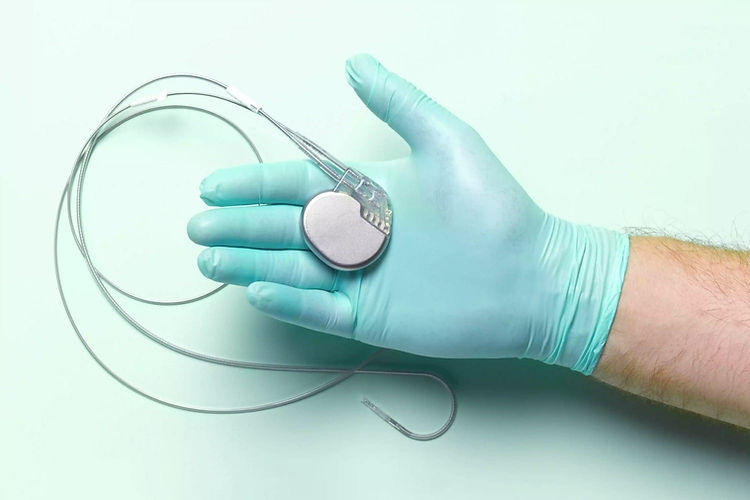Pacemakers

Sick sinus syndrome
Causes
•AMI, ischemia
•Athletic training
•Cardiac surgery
(Valve replacement, maze procedure, bypass grafts)
•Drugs/toxins/medications
(Cocaine, toluene, tetrodotoxin, organophosphates, beta blockers, calcium channel blockers, digoxin, antiarrhytmics)
•Metabolic imbalances
(Hyper/hypokalemia, hypoglycaemia)
•Infections
(Lyme disease, legionella, typhoid, dengue, guillian barre)
•Other
(Hypothermia, OSA, suffocation, drowning, stroke)
Indications
Class I
•Directly correlating symptoms (Sx) sinus bradycardia (C)
•Direct Sx SSS due to necessary drug therapy (C)
Class IIa
•Tachybrady syndrome with bradycardia Sx (C)
•Sx chronotropic incompetence (RR) (C)
Class IIb
•Sx likely due to SBc, a trial of oral theophylline may be considered to increase HR, improve symptoms, & help determine the potential effects of PPM
Class III
•Asymptomatic (inc sleep) SBc, sinus pause
•Sx do not correlated with SBc
Implant Type
Single chamber – Ventricular lead only
•Infrequent pacing/significant comorbidities (IIa)
Single chamber – atrial lead only
•Normal AV conduction & reason to avoid RV lead (I)
Dual chamber
•Normal AV conduction with no reason to avoid RV lead (I)
•Program to minimise V pacing (IIa)
AV node dysfunction (AVD)
Types of AVD
1st degree AV block
•Prolonged PR interval
2nd degree AV block
Type I (Wenckebach)
•Progressive PR lengthening followed by non conducted beat
Type II
•Intermittent non conducted p waves without progressive PR prolongation of the PR interval (often written in ECG text books, but does not accurately describe type II block)
•Typically broad complex QRS, typically >1 dropped beat & typically abnormal baseline PR interval
3rd degree AV block
•Complete dissociation of atrial & ventricular activity
(more P waves then QRS complexes)
Causes
•Congenital, genetic (SCNA5 mutations)
•Infections
(Lyme disease, Chagas, Rheumatic fever, endocarditis)
•Inflamatory
(Myocarditis, amyloidosis, cardiac sarcoidosis, cardiomyopathy)
•Ischemia
•Drugs
(Verapamil, beta blockers, digoxin, antiarrhythmics, posion, OD)
•Other
(Neuromuscular disease, thyroid disease, adrenal disease)
•Procedural
(TAVR, catheter ablation, valve surgery)
•Vagally driven
(Sleep, OSA, athletic, neurocardiogenic)
Implant Type
Note: excluding CRT indications
Single chamber – Ventricular lead only
•Infrequent pacing/significant comorbidities (I)
•Permanent AF (I) (dual chamber – class III)
Dual chamber
•LVEF >50% (IIa)
•LVEF <50% & predicted pacing <40% (IIa)
•LVEF <50% & predicted pacing >40% (IIa (CRT) or HIS (IIb)
•SR with VVI PPM who develop PPM syndrome (I)
•HIS leads are considered a class Iib indication for all AVD pts
Indications
Class I
•Non reversible 2/3/high grade AVD – asymptomatic (B)
•Neuromuscular disease with 2/3 AVD or HV >70ms – asymp (B)*
•Permanent AF with symptomatic brady (C)
•AV block from required medical management with symptoms (C)
Class IIa
•Infiltrative cardiomyopathy 3/2II/high grade AVD (B)*
•Lamin A/C gene mutations, PR>240ms & LBBB (B)*
•Marked 1AV or 2AVI w HF symptoms (C)
Class IIb
•Neuromuscular disease PR>240 & QRS>120 or fasicular block (C) *
*meaningful survival >1yr with or without ICD capabilities.
Fasicular Block
Indications
Class I
•Syncope, BBB HV >70ms (C)
•Alternating BBB (C)
Class IIa
•Kearns-Sayre syndrome & conduction disorders * (C)
Class IIb
•Anderson-Fabry disease, QRS >110ms * (C)
•HF symptoms, mild-moderately reduced LVEF (36-50%) & LBBB (>150ms) CRT may be considered (C)
Class III
•Asymptomatic isolated conduction disease (B)
Pre/peri/post surgery
Indications
Class I
•Persistent SND/AVD post card surg (CAGs, AoV, MV, TV, AF abl, HCM septal abl) with symptoms or hemo instability (B)
Class IIa
•During TV surg who are high risk of AVD, epicardial leads (C)
•HCM post septal, need for brady pacing and ICD (B)
Class IIb
•During cardiac surg (CAGs, AoV, MV, AF abl) epicardial LV lead if CRT or Vp likely required in the future (C)
•Post TAVI, persistent new LBBB (B)
Class III
•LBBB who require pulmonary artery catheterisation for intraop monitoring
Adults with congenital heart disease (CHD)
Indications
Class I
•CHD & symptomatic SND – A base PPM (B)
•CHD & symptomatic AVD (B)
•Congenital CHB – symptomatic BC, wide QRS escape, mean daytime <50, complex VEs, or ventricular dysfunction (B)
•CHD, post op persistent 2II/3/high grade AVD (B)
Class IIa
•Asymptomatic congenital CHB (B)
•Repaired CHD w brady indications with atrial ATP cap (B)
•CHD with SND/AVD for cardiac surg, epidcardial leads (C)
Class IIb
•CHD & PPM – A based pacing for atrial arrhythmia prevention (B)
Class III
•CHD with venous to systemic intracardiac shunts (B)
Post acute phase MI
Indications
Class I
•Present with SND/AVD in setting of AMI – undergo a waiting period before determination of PPM (B)
Class III
•AMI with transient AVB that resolves (B)
•AMI with new BBB/fasicular block without 2/3 AVB
Vasovagal Syncope
Indications
Class IIa
•Pts >40yrs with recurrent unpredictable syncope with documented >3s symptomatic pause or >6s asymp pause (B)
Class IIb
•Paed pts with recurrent syncope with documented asystole who are refractory to medical therapy (B)
•Adenosine-susceptible older pts who have unexplained syncope without a prodrome, normal ECG and no SHD (C)
Other
Indications
Class IIa
•Epilepsy associated with severe symptomatic ictal bradycardia where antiepileptic medications are ineffective (C)
•Discontinuation of pacing therapy when pt presents for gen change or management of PPM related complication where the original pacing indication has resolved or is in question, after a period of monitoring while pacing therapy is off has been assessed (C)




